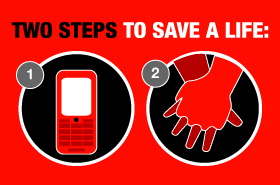
HEART ATTACK WARNING SIGNS
CHEST DISCOMFORT
Most heart attacks involve discomfort in the center of the chest that lasts more than a few minutes, or that goes away and comes back. It can feel like uncomfortable pressure, squeezing, fullness or pain.
Most heart attacks involve discomfort in the center of the chest that lasts more than a few minutes, or that goes away and comes back. It can feel like uncomfortable pressure, squeezing, fullness or pain.
DISCOMFORT IN OTHER AREAS OF THE UPPER BODY
Symptoms can include pain or discomfort in one or both arms, the back, neck, jaw or stomach.
SHORTNESS OF BREATH
with or without chest discomfort.
OTHER SIGNS
may include breaking out in a cold sweat, nausea or lightheadedness.
Spot a stroke F.A.S.T.:
- Face Drooping Does one side of the face droop or is it numb? Ask the person to smile.
- Arm Weakness Is one arm weak or numb? Ask the person to raise both arms. Does one arm drift downward?
- Speech Difficulty Is speech slurred, are they unable to speak, or are they hard to understand? Ask the person to repeat a simple sentence, like "the sky is blue." Is the sentence repeated correctly?
- Time to call 9-1-1 If the person shows any of these symptoms, even if the symptoms go away, call 9-1-1 and get them to the hospital immediately.
- Face Drooping Does one side of the face droop or is it numb? Ask the person to smile.
- Arm Weakness Is one arm weak or numb? Ask the person to raise both arms. Does one arm drift downward?
- Speech Difficulty Is speech slurred, are they unable to speak, or are they hard to understand? Ask the person to repeat a simple sentence, like "the sky is blue." Is the sentence repeated correctly?
- Time to call 9-1-1 If the person shows any of these symptoms, even if the symptoms go away, call 9-1-1 and get them to the hospital immediately.
SUDDEN LOSS OF RESPONSIVENESS
No response to tapping on shoulders.
No response to tapping on shoulders.
NO NORMAL BREATHING
The victim does not take a normal breath when you tilt the head up and check for at least five seconds.
| Learn more about heart attack. | Learn more about stroke. | Learn more about cardiac arrest. |
 |
| Dial 9-1-1 Fast Heart attack and stroke are life-and-death emergencies — every second counts. If you see or have any of the listed symptoms, immediately call 9-1-1 or your emergency response number. Not all these signs occur in every heart attack or stroke. Sometimes they go away and return. If some occur, get help fast! Today heart attack and stroke victims can benefit from new medications and treatments unavailable to patients in years past. For example, clot-busting drugs can stop some heart attacks and strokes in progress, reducing disability and saving lives. But to be effective, these drugs must be given relatively quickly after heart attack or stroke symptoms first appear. So again, don't delay — get help right away! |
| More about heart attack |
Learn the signs, but remember this: Even if you're not sure it's a heart attack, have it checked out (tell a doctor about your symptoms). Minutes matter! Fast action can save lives — maybe your own. Don’t wait more than five minutes to call 9-1-1 or your emergency response number. |
| More about stroke |
A TIA or transient ischemic attack is a "warning stroke" or "mini-stroke" that produces stroke-like symptoms. TIA symptoms usually only last a few minutes but, if left untreated, people who have TIAs have a high risk of stroke. Recognizing and treating TIAs can reduce the risk of a major stroke.
|
| More about cardiac arrest |
If you are alone with an adult who has these signs of cardiac arrest, call 9-1-1 and get an AED (if one is available) before you begin CPR. Use an AED as soon as it arrives. |

Hands-Only CPR can be as effective as CPR with breaths. Watch the demo video and learn how to save a life in 60 seconds.